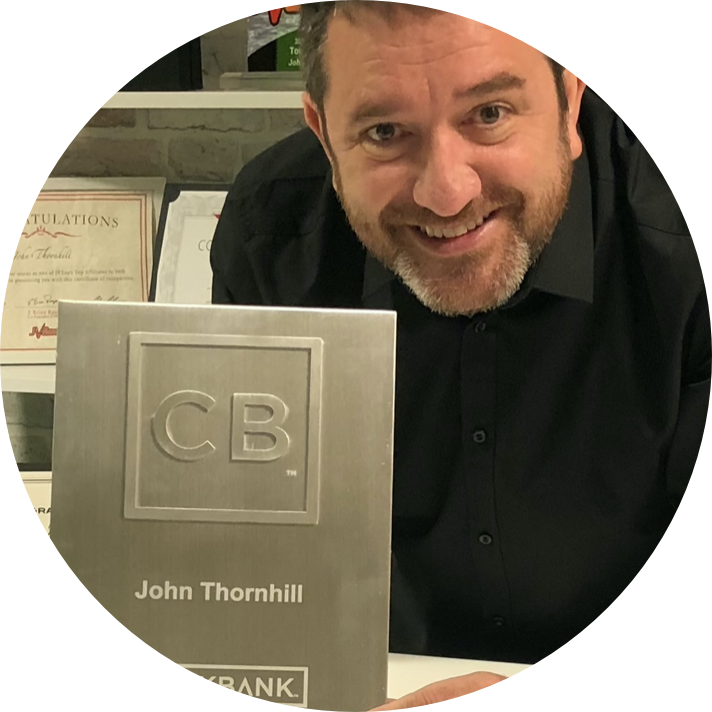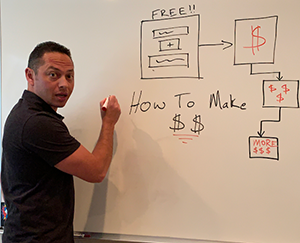Fractional CMOs As Strategy Architects with Angelo Ponzi written by John Jantsch read more at Duct Tape Marketing
The Ducttape Marketing Podcast with Angelo Ponzi In this episode of the Duct Tape Marketing Podcast, I interview(ed) Angelo Ponzi. This week, we´re going to be re-gifting you your favorite episodes! Angelo Ponzi is a marketing and branding strategist who works with small to middle-market companies as their Fractional CMO. His company, Craft, focuses on […]
Fractional CMOs As Strategy Architects with Angelo Ponzi written by John Jantsch read more at Duct Tape Marketing
The Ducttape Marketing Podcast with Angelo Ponzi
In this episode of the Duct Tape Marketing Podcast, I interview(ed) Angelo Ponzi. This week, we´re going to be re-gifting you your favorite episodes! Angelo Ponzi is a marketing and branding strategist who works with small to middle-market companies as their Fractional CMO. His company, Craft, focuses on three strategic pillars for success: Insights, Brand, and Plan. These pillars are to develop effective and efficient programs for building enduring brands and sustainable business growth.
Key Takeaway:
Fractional CMOs, besides being a flexible and cost-effective solution for businesses, contribute to long-term growth through strategy development, messaging refinement, and navigating marketing challenges. Angelo highlights the importance of balancing new business endeavors with client service when operating one’s agency. Staying actively engaged in networking and marketing efforts is essential to remain present in the fractional CMO arena and seize potential opportunities.
Questions I ask Angelo Ponzi:
- [01:12] How do you define the term Fractional CMO?
- [02:02] What kind of business and what kind of challenges are they facing that you think makes an ideal fit for a fractional strategic marketing hire?
- [03:34] If somebody hires a CMO, do they feel like they’re also hiring an implement mentor, or are they strictly separate functions?
- [04:57] Are there ever some turf wars, even though you’re brought in to help them orchestrate better?
- [06:25] Besides the cost component, what other things might you suggest about the fractional CMO model being a good idea for businesses?
- [09:52] Are you finding much more recognition of the concept and the term, particularly for midsize business owners?
- [11:04] What hard lessons have you learned as a Fractional CMO?
- [13:05] How do you scale this model?
- [18:03] Do you focus on the same thing frequently?
If you enjoyed this episode, check out the Ultimate Guide to Scaling a Fractional CMO Business.
(00:30): Hello and welcome to another episode of the Duct Tape Marketing Podcast. This is John Jantsch, and my guest today is Angelo Ponzi. He’s a marketing and branding strategist that works with small to mid-market companies as their fractional chief marketing officer, fractional CMO. His company Craft focuses on three strategic pillars for success, insights brand and plan to develop effective and efficient programs for building enduring brands and sustainable business growth. So Angela, welcome to the show,
Angelo Ponzi (01:03): John. Thank you very much. I really appreciate it.
John Jantsch (01:05): So I still think there’s a lot of confusion around it, like a lot of terms in marketing. So I’m just going to go ahead and say, if somebody says you, you’re a fractional CMO, what is that? How do you describe that? How do you define that term?
Angelo Ponzi (01:17): Yeah. Well, I think simply it’s a part-time outsource contract situation. So for me, fractional being that it’s not a short-term contract, it’s a long-term engagement where I’m going into the organization or depending on my remote client, where I’m engaged on a weekly basis, sometimes daily basis with them. And so think of me as the guy down the hallway, not the guy across the country. Yeah.
John Jantsch (01:48): So I mean, would you describe a business that you think is a typical great fit for that? I mean, most people are familiar with the C-Suite roles, a chief marketing officer inside of an organization, but what kind of business or what kind of challenge are they facing that you think makes an ideal fit for a fractional strategic marketing hire?
Angelo Ponzi (02:10): Sure. In most of the companies that I’ve dealt with, they have some kind of a marketing manager or a team in there. Typically, they tend to be a little more transactional in nature, just tactically oriented. And so I hear things like, our sales aren’t growing, our messaging is not correct. Our competition is eating our lunch. And so looking at those kinds of issues, so they can’t get to that next level with someone who’s more of a tactical transactional person. So they may start to think of a strategic person, however, a full-time CMO doesn’t necessarily come cheap. And so they wrestle with how do I get a senior person without having to have all that expense? And that’s typically what get engaged or when they’ll call me, because again, depending on the client, how much time I’m engaged, but I sit in that C-suite level and helping develop strategies and directions and messaging and competitive differentiators, and then drive those down into the people that actually execute.
John Jantsch (03:21): Do you get yourself in engagements where they’re like, Angelo, this is great, but who’s going to do all this? I mean, is there ever an expectation that you are going to do the work or that any strategic, if somebody hires A CMO, do they feel like they’re also hiring an implement mentor, or is it strictly separate functions?
Angelo Ponzi (03:43): Yeah, well, that’s always the dilemma for me. It’s my nature to tend to go across the line and start facilitating and doing, but I’m pretty clear upfront is what my purpose is. If someone calls me and says, look it, I need a website, I need a social media or digital campaign, my reaction is let’s talk about your messaging, your strategies, and if that’s not correct, I have to start to the left, right? I got to talk to your customers that look at the competition, examine the marketplace and work our way towards execution. So I like to refer to myself sometimes as an architect, I’m building that foundational strategy. And then once the plans are in place, then I will sometimes call myself a general contractor and therefore I’ll bring in outside people to execute or work with the internal teams. But I do cross the fence, but a lot of times they’re like, I’m not going to pay you to frankly write a blog. It’s too expensive.
John Jantsch (04:44): Yeah. So do you find internal teams, I hear this a lot. Do you find that sometimes there’s some turf? Like, wait a minute, I thought that’s what we did. Why are we bringing in this outside person doesn’t know our business? Is there ever some turf wars sometimes, even though you’re brought in maybe to help them orchestrate better?
Angelo Ponzi (05:03): I can honestly say, actually, I can honestly say it’s only happened maybe once or twice where I’ll spend, I’m thinking of a technology company. A couple of years ago they brought me in, the marketing person was out of college for a couple of years. He had his own vision. They brought me in, I revamped everything, redid all their messaging, their plans, and then here’s the plan to implement. And within three months, he was back doing what he wanted to do because they didn’t know how to really manage him. But I would say in most situations, I’m very collaborative, so it’s not my way or the highway. So I find that even after I leave, they’re implementing. I have a company in the streaming space that I helped them when they launched. That was five years ago. When I see him constantly, he’ll be the first to say, I’m still working on the strategies you gave us five years ago. And so that’s really rewarding. But yeah, that is always a challenge, right? Because not invented here, somebody wants to put their own mark on it.
John Jantsch (06:08): Yeah. I’m sure there are some cases, I’m going to assume there’s some cases you’ve run into where they’re considering hiring you versus considering hiring a full-time strategic hire. If you were trying to help somebody work through the pros and cons, besides the cost component, which is obviously a huge selling point on the fractional approach, what are some other things that you might suggest that why the fractional CMO model is a good idea for them?
Angelo Ponzi (06:39): Well, partially too. It’s really what does that strategic leader need to do and what is the long-term play with that leader? Are you going to have somebody who’s who can totally stay engaged throughout the time and do all the things that you need ’em to do, otherwise they start to gravitate into the tactical and then you don’t really need that. I have a current client where we’re looking, I’m filling the strategic leader role, and at the end of the day, they don’t need a full-time me, but they need more worker bees, if you will. And so my recommendation is keep me engaged. Of course, that’s what I would like, but instead of hiring someone like me full-time, take that money and then let’s invest in more people at the real marketing level that the tactical level that needed to get things done. I was brought in last year with a consumer products company that had a CMO.
(07:35): They let him go, and he called me and said, Hey, I’m thinking about hiring. I think I need a fractional. And then about three weeks later, he called me and said, no, you know what? I decided to go. And then three months later, he called me and said, I haven’t found anybody. I think my original idea was great, come in for 90 days, help me. And I was there for eight months before we brought in. I helped bring in my own replacement at that point in time. They really needed somebody there. And there was a situation where I was there three days a week, so I literally was in the office and spending the majority of my time working for that organization.
John Jantsch (08:12): Do you find that to me, one of the benefits I think too, is a lot of times you bring in that CMO, well, they’re going to say, we need to build a team internally. And so they start kind of down the traditional path of hiring, whereas I’m assuming that in many cases you kind of look at this and say, no, we just need this expertise to do this one thing, and then we can rent this to do this one thing. And I mean, you’re really able to put together a much more affordable approach for exactly what they need, aren’t you?
Angelo Ponzi (08:41): Yeah, no, absolutely. It’s current client, they had a digital firm primarily writing blogs, and I analyzed it, and every blog had to be rewritten. And after eight, nine months, you would’ve thought that they understood the business. So I tried to engage with them, and ultimately we ended up parting ways. But instead of hiring another firm just like them, I went out and found a content writer that for a fraction of the cost, I could have twice as many blogs for literally a third of the money that I was paying them already. And so that is one of the things I look at. To me, I always look at any client I work with is my business. I was fortunate to, over the years, I grew a couple of businesses, I was fortunate to sell them, and I understand that a dollar is a dollar, and if I have to watch it for me, I have to watch it for you. So it’s really about maximizing the talent and the dollars that we have.
John Jantsch (09:42): I have been doing this approach probably for 15 years, but didn’t use the term fractional CMO because it didn’t mean anything to a small mid-size business at the time. Are you finding there’s a much more recognition of the concept and the term when you go out and talk to particularly mid-size business owners?
Angelo Ponzi (10:00): Yeah, absolutely. And I’ll go back. I mean, I’m heading into my 10th year, and in those first three or four years, it was like, I don’t understand what a fractional is. Are you contract? Are you outsourced? What are you, right? So there was different terms floating around. I haven’t had anybody really recently say they don’t understand it. I just say, you’re renting my time basically during the course of the week. So I think it’s better understood. I’d even think some of the value of having someone like myself that clients find now versus because it’s a tough decision, do you spend that kind of money? I had a client the other day that, again, looking at bringing in more workers than strategic leaders, and he said to me, well, what if we could hire you? And I suppose my answer was, you can’t. It’s not what I want to do because I knew I would eventually, I would just be pulling my hair out because they don’t need someone full-time like me.
John Jantsch (11:00): So as you’ve grown this and scaled it yourself, are there some hard lessons learned that you might share to say these are some of the landmines that you might look for?
Angelo Ponzi (11:14): Well, I think first of all, for me, and unfortunately it was a very hard lesson. I had an opportunity back in maybe 17, I think it was, to go in as a fractional, but it was like an eight month contract. And I was like, this is great. The money was great. I was excited, and when the contract was over, I was sitting there. I have no business. I wasn’t doing any marketing, I wasn’t keeping the pipeline. So anybody out there listening, if you’re doing what I do or something even similar, having your own agency, I mean, it is a constant balance of doing new business while you’re servicing the clients. I personally now, I would say in the course of the week, I spend a full day throughout the week, but networking, doing my own marketing, doing stuff like this and just making sure that I’m staying ever present, because you just never know.
(12:09): I mean, I have one prospect that I pitched in February. He literally said, you’re hired, but there’s no contract yet. Now it’s August. I still think you’ll come around, but I’m on his time. He’s not on my time. So that’s probably the biggest lesson that I’ve learned and making sure that you have a point of view and you put yourself out there. I mean, I have a blogging program, a newsletter program. I do emails, I do LinkedIn, I do public speaking. I just want to be able to have content. It’s all content to me to refer
John Jantsch (12:44): People too. Absolutely. Yeah. We actually teach people how to start this model, and I tell them, especially when they’re just getting started, I said, the thing nobody tells you is about 50% of this job is selling, but that’s true of really any business. When you start it, that kind of leads to one of the challenges I see a lot of people, how do you scale this model? I mean, in the traditional sense, somebody’s A CMO, they jump out on their own. They go, I’m going to be a fractional CMO, and they end up selling a fourth of their time and basically saying, I’m fully employed. I’m getting paid well for my time, but I can’t really scale a business. Have you run into that? Have you addressed that?
Angelo Ponzi (13:25): Yeah, it’s a really interesting challenge. So before I formed my agency, for example, this was many years ago, I actually, they didn’t call it fractional, but I broke off as a consultant. And so I left an agency, decided to be a strategic planner for agencies, and then eventually I came to the conclusion after about three years, why am I doing this for you? Why don’t I do it for myself? And so I kind of scaled that. So in this particular model for me, I have identified other CMOs, fractional CMOs or VP leaders, if you will, that are out on their own that I can partner with. One of my biggest clients last year is actually a competitor, but I have a background in research. So they don’t do research. They don’t do really branding and messaging and positioning. They’re more kind of internal management. And so we compliment each other.
(14:28): So one of the things that I did to scale is I identified in my trading area who my competitors are. I’ve literally met with every one of ’em trying to figure out are we really competitors or can we work together? And I would say the majority of ’em I can work with. And so I’ve also identified in some of the other key areas. So I have a business analyst that works with me that I pretty much dominate. I have a data scientist that works with me. I have a brand strategist that actually I worked with for years, even in my own agency that happened to, I lost their job during covid and now works for me as kind of a behind the scenes. So I’ve been scaling by putting other people in place, frankly, to do some of the work that allows me to continue to devote some of my time to networking and building the business, but also when I have to be in front of a client,
John Jantsch (15:23): The mistake I see some people make is just like, you get 25% of my time, what do you want? And it’s like they’re dictating. There’s no scope in agencies. We’d scope things out. And I see a lot of people when they do these consulting things, they don’t do that. And so they’re sort of at the whim of a client who doesn’t really know what they need. And I think that’s a key change that I think can allow people to scale this.
Angelo Ponzi (15:51): Yeah, well, one of the things I did to get around that is I created an assessment that I give at the beginning of every engagement just to really try to understand where they think they are, where they really are, where they think they are, but also among the team, I look for alignment, internal alignment. And so that has allowed me to actually through the analysis to say, okay, here’s where we’ve got some real issues and some problems you want to be, I’m just going through this with a client now where when I joined them back in February, they had a $5 million goal for this year increase in revenue. Well, as I started to dig into the data, it’s like, where’d that number come from? Your average growth is only 8% over the last three years. How do you go from 8% frankly to a 37% increase?
(16:39): I don’t see how you’re getting there. So some number was picked out of the air. So trying to bring, creating strategies, now that’s giving me guidance as opposed to, what do you think? If I would’ve just said, okay, I’m going to support a 37% increase, which I did originally, and then eventually I’ve swung them back to say, okay, how are we going to get, maybe it’s 15%, not the eight, but the 15. And I literally just said this to one of my marketing managers today. There’s an endless amount of things to do in marketing. You’ve got a plan and you always go back to the plan and just if you got, you are unsure of your messaging or somebody in sales is pushing back on you, try to understand what’s happening with them. Go talk to them, go listen to a call. So I find that sometimes in that marketing manager role, they tend to go, oh, well, that was my assignment. I did it and now what do I do?
John Jantsch (17:34): Yeah. It’s interesting. I find that we spend as much time, especially early on telling people what not to do as opposed to what to do, because always this temptation to say, oh, there’s a new thing out there. We have to do it. As opposed to doing any of them, right?
Angelo Ponzi (17:51): Yeah, exactly.
John Jantsch (17:52): And that’s what I was going to ask you kind of halfway answered it anyway, but let’s say we get through the assessment. Obviously the assessment’s going to tell you maybe some direction, but do you typically focus on, do you find that you end up focusing on the same thing pretty frequently? What to fix first, so to speak?
Angelo Ponzi (18:10): Actually, no, because they have, it’s like our sales aren’t growing or we’re not achieving, or we think we have an issue. And I have found that if I can execute my assessment in the process that I do, I can uncover things that they’re not thinking about. Good case in point, this was last year working with a manufacturing rep organization, been around for 70 plus years. And so in talking to them and say, our clients love us, they’re mechanical engineers, they know us. We’ve been, we’re a focus. We’re always included, but I got them to agree to let me talk to their customers. Originally it was like, wow, I don’t waste your time. What we found is that they were right. Everybody knows them, everybody includes them. However, their primary customers were about ready to retire. The new generation of engineers had no idea who they were or knew them, but they were now thinking about environmental products and sustainability products, not the gas guzzlers, if you will, that are being put out. And so all of a sudden we identified a potential opportunity that they would’ve never seen until it happened. So now they were able to get ahead of it. So it’s that kind of stuff that we get to uncover, but that wasn’t one, that wasn’t something they told me to go do. That was just something that came, cream of the cop came rising up and we able to tackle it.
John Jantsch (19:41): Yeah, I have had so many insights over the years by talking to people’s customers. I mean, they know very little about why their customers buy from them sometimes. It’s pretty amazing, isn’t it? Or they make assumptions that are wrong
Angelo Ponzi (19:53): Or what the salespeople tell ’em. Right? Right. There’s a question I always like to ask is I ask the clients, do you think your clients are buying, are aware of all the products and services you sell? And almost always they say no. And to me it’s like, well then what are you doing to educate them? You could be leaving a lot of money on the table if they just knew more. And then we find out I asked those questions on the flip side, and almost across the board, the client will say, now I don’t really understand all the stuff they sell. I only know this. So right there, there’s a gap, right. So anyway,
John Jantsch (20:30): It’s fine. Yeah, that’s actually some easy money sometimes, isn’t it? Well, Angela, I appreciate you taking a moment to stop by. You want to invite people to connect with you anywhere or find out more about your work.
Angelo Ponzi (20:39): Sure. That would be great. The best place, of course, is to go to LinkedIn. You can connect with me there. That’s the easiest. Also, all my contact info is there. As far as my website, I actually encourage people to sign up. I do publish a newsletter through LinkedIn every couple of weeks, and so do that. And that’s the best way to find out more about me.
John Jantsch (20:59): Awesome. Well, again, I appreciate you taking a few moments out of your day, and hopefully we’ll run into you one of these days out there on the road.
Angelo Ponzi (21:05): Yeah, absolutely. Thank you so much. I really appreciate the opportunity.
Sign up to receive email updates
Enter your name and email address below and I’ll send you periodic updates about the podcast.
Recommended Story For You :

How To Make $3493 Commissions Without Doing Any Selling

Successful dropshippers have reliable suppliers.

People Think I Use A Professional Voiceover Artist. NO! I Just Use Speechelo!

Make Money Testing Apps On Your Phone Or Tablet

Make More Money or Lose Everything

Sqribble Is The ONLY eBook Creator You’ll Ever Need.

Work & Earn as an Online Assistant

Create Ongoing Income Streams Of $500 To $1000 Or More Per Day

It's The Internet's Easiest Side Business.





